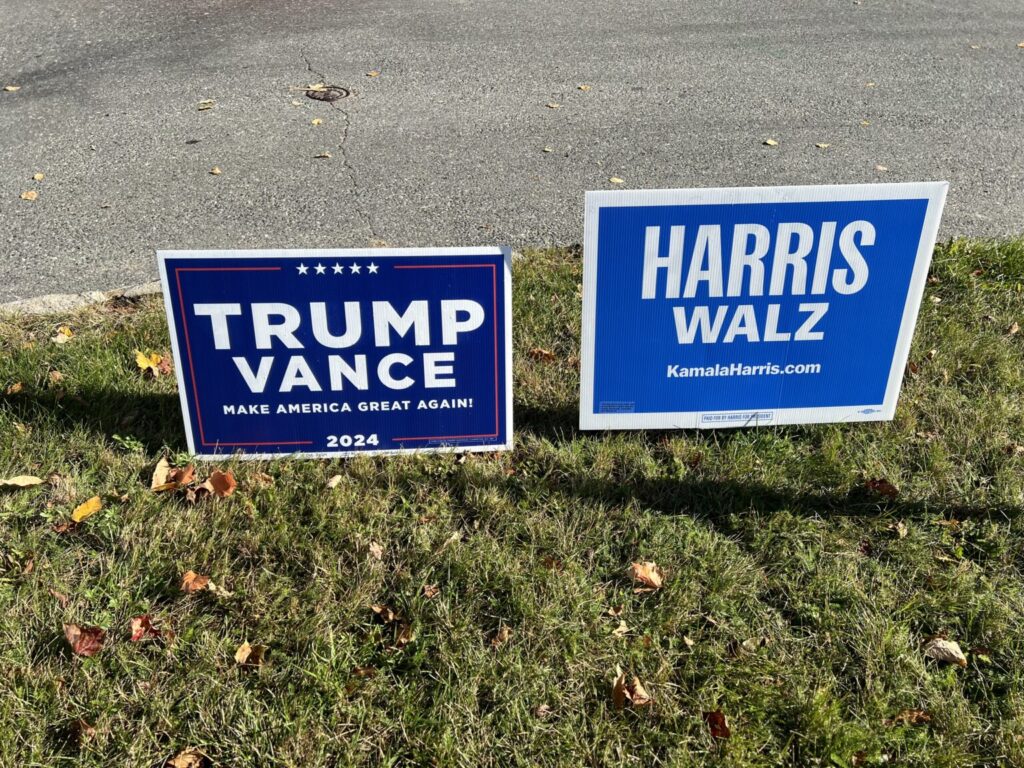
Campaign signs for former President Donald Trump and Vice President Kamala Harris, the respective GOP and Democratic presidential nominees, appear Sunday, Oct. 20, 2024, on Mount Desert Island in Maine. Photo by Shauneen Miranda/States Newsroom.
Welcome to The Topline, a weekly roundup of the big numbers driving the Minnesota news cycle, as well as the smaller ones that you might have missed. This week: why polls are all over the place; an early voting update; the geography of mental health; and support for dictatorship.
What’s the deal with the polls?
The latest polling shows Harris up 3 points in Minnesota.
Wait, scratch that: The latest polling has Harris up by 8.
Hold on: The latest polling shows Harris is actually up by 10 points in the state.
How is it possible that three credible, nonpartisan, well-regarded polls conducted in the final month of the campaign are yielding such radically different results?
The answer lies, at least in part, in highly technical, behind-the-scenes adjustments pollsters make to their raw data in the hopes of making it more accurate. Because random survey samples never precisely line up with the demographics of an entire population, pollsters have to weight the responses they get in order to get a representative dataset.
On top of that, they have to figure out which respondents actually plan to vote (or already have), versus the ones who don’t follow through.
In short, modern polling involves a lot of putting thumbs on scales in the name of accuracy. Those decisions are driven by assumptions about demographics and voter behavior that may or may not be accurate. And different weighting decisions can conjure up dramatically different results from the same dataset.
Josh Clinton, a political science professor at Vanderbilt University who co-directs the university’s poll, wrote an illuminating article last week about how various reasonable and defensible weighting decisions can shift a survey’s final margin by 8 percentage points. And that’s before you get into the differences that naturally arise between multiple samples of the same population, or as a result of pollsters’ different surveying methods.
While the polls are generally in agreement that Harris and Walz are going to win Minnesota, the final margin is very much up in the air.
Early voting update
MPR reports that as of Nov. 1, about 32% of the state’s 3.7 million registered voters have requested an absentee or mail-in ballot. Roughly 27% of the electorate has already cast their votes (aside: what effect does all that early voting have on surveys conducted in the final weeks of a campaign?).
In 2020, 58% of voters eventually cast their ballots early or absentee, largely because of the COVID-19 pandemic. While we won’t hit that number again this year, it will be interesting to see whether early voting reverts to the pre-pandemic baseline or whether the pandemic ushered in durable changes to voter behavior.
The geography of mental health
Speaking of the election, how’s your mental health holding up? Earlier this year USA Facts published the latest geographic data on mental health in the U.S., which revealed an interesting trend: There’s an east-west gradient to mental illness, with people in eastern states having generally lower rates than those out West.
While fewer than 20% of New Jersey residents reported having a mental illness in 2022, the share among Utahns was 29%.
One reason for this is that rates of mental illness are higher in rural areas, and western states tend to be more rural than their eastern counterparts. Poverty, social isolation and lack of access to care are among the drivers of rural mental health problems.
Minnesota’s rate of mental illness was 24.7%, slightly above the national average of 22.8.
1 in 8 likely voters is open to dictatorship
Five percent of likely voters recently told pollsters with the McCourtney Institute “it makes no difference” whether they live in a democracy or under a dictatorship, while an additional 7% said that in certain circumstances a dictatorship “could be a good thing.”
These aren’t random, alienated non-voters, but rather some of the people most likely to participate in this year’s election.
Guess which presidential candidate they preferred?

